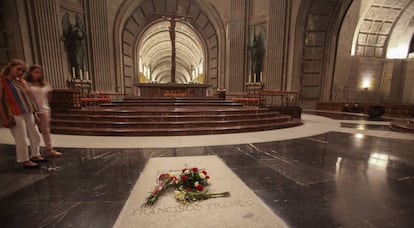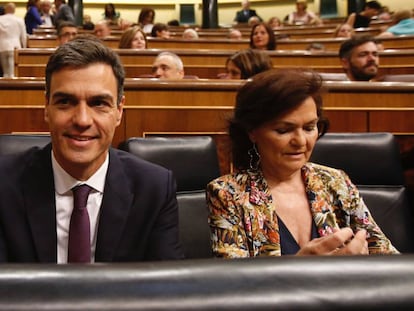Government to use decree to give legal coverage to plans to exhume Franco¡¯s body
The move is likely to count on the support or abstention of other political parties, with the surviving family of the former dictator most likely to oppose


The Spanish government has settled on the legal formula it believes will provide the greatest protection for its plans to exhume the remains of former Spanish dictator Francisco Franco from the Valley of the Fallen memorial site. According to government sources, this will be a legislative decree that will add a pair of articles to the Historical Memory Law, giving the move the greatest legal coverage possible.
The government is confident the legislative decree will pass Congress
For the last two weeks, the government of Socialist Party (PSOE) Prime Minister Pedro S¨¢nchez has been reviewing the measure to ensure it does not fail. The pledge to remove Franco¡¯s body from the controversial monument, located north of Madrid, has been one of the government¡¯s landmark decisions and will have wide-reaching consequences both nationally and internationally. The government wants to ensure the move is not derailed by a lawsuit filed by the Franco family, something that could potentially deal a serious blow to the image of the new government.
After evaluating all possible legal routes, the government has decided that the best way forward is for the Cabinet to approve a legislative decree, which will then have to be passed by Congress. This decree will add a pair of articles to the Historical Memory Law to safeguard the exhumation. Only Congressional groups can bring a complaint against a law and the government is confident the conservative Popular Party (PP), while opposed to the measure, will not take such a drastic measure.
The PP may even abstain from the vote rather than vote against it. On the issue of Franco¡¯s exhumation, PP leader Pablo Casado said: ¡°I am never going to defend this building nor who is buried within, for family reasons as the grandson of a man persecuted by the Franco regime, but Spain has to look to the future.¡± Casado¡¯s grandfather was sent to prison for being a member of the General Workers¡¯ Union (UGT) during the Franco regime.
Lengthy process
While the legislative decree is imminent, the process to exhume Franco¡¯s body will take much longer. First, an administrative case must be opened, all parties ¨C especially the family ¨C have to be notified and then an agreement needs to be reached. It could be weeks, according to the government¡¯s calculations. The government is hoping to carry out the exhumation with the support of the family but is prepared if the decision reaches the courts.
Meanwhile, center-right party Ciudadanos is likely to vote in favor of the legislative decree, having backed an earlier initiative to exhume Franco¡¯s remains when PP leader Mariano Rajoy was still in power.
The government has also overcome the potential obstacle presented by the Catholic Church. The body of the dictator is buried in a basilica, a holy site theoretically protected by an international agreement. But from the outset the Church has been receptive to the government¡¯s plans. S¨¢nchez spoke with the archbishop of Madrid, Carlos Osoro, who assured there would be no opposition on their part.
The only real challenge facing the government is presented by the family of the dictator. For a number of weeks, the government tried to convince Franco¡¯s seven grandchildren to support the initiative but the efforts failed and at the end of July the grandchildren wrote a letter expressing their rejection of the proposed exhumation.
The Church has said it will no oppose the exhumation
The legislative decree, designed to get around the family¡¯s objections, will be a short text to fast-track its approval in Congress. It is not likely to include any mention of what will happen to the Valley of the Fallen once Franco¡¯s remains are removed ¨C an issue that has divided both historians and politicians.
The 13.6-square kilometer Valley of the Fallen site remains hotly contested in a country still struggling to come to terms with the legacy of the fascist dictatorship of Franco, who was the Spanish head of state from the end of the Civil War in 1939 to his death in 1975.
The site was ostensibly built to commemorate all of the victims on both sides of Spain¡¯s bitter and bloody Civil War, and the remains of more than 33,000 victims of the conflict lie there. But critics point out that the Valley of the Fallen, which features a basilica and a 150-meter-high cross that? dominates the surrounding countryside, contains just two marked graves: those of Franco himself and Jos¨¦ Antonio Primo de Rivera, the founder of the Falange, Spain¡¯s fascist-inspired political party. At the same time, thousands of prisoners of war who fought against Franco in the civil conflict were among the workforce used in its construction.
English version by Melissa Kitson.
Tu suscripci¨®n se est¨¢ usando en otro dispositivo
?Quieres a?adir otro usuario a tu suscripci¨®n?
Si contin¨²as leyendo en este dispositivo, no se podr¨¢ leer en el otro.
FlechaTu suscripci¨®n se est¨¢ usando en otro dispositivo y solo puedes acceder a EL PA?S desde un dispositivo a la vez.
Si quieres compartir tu cuenta, cambia tu suscripci¨®n a la modalidad Premium, as¨ª podr¨¢s a?adir otro usuario. Cada uno acceder¨¢ con su propia cuenta de email, lo que os permitir¨¢ personalizar vuestra experiencia en EL PA?S.
En el caso de no saber qui¨¦n est¨¢ usando tu cuenta, te recomendamos cambiar tu contrase?a aqu¨ª.
Si decides continuar compartiendo tu cuenta, este mensaje se mostrar¨¢ en tu dispositivo y en el de la otra persona que est¨¢ usando tu cuenta de forma indefinida, afectando a tu experiencia de lectura. Puedes consultar aqu¨ª los t¨¦rminos y condiciones de la suscripci¨®n digital.










































